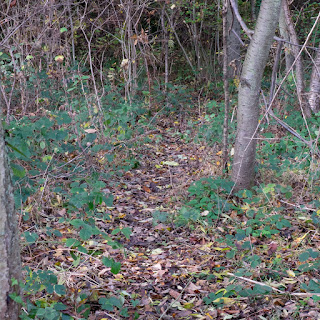- The obvious paths. Some of these may be 'single track', or broader paths/forest tracks down which vehicles have travelled. These images always show the path disappearing around a corner so the viewer has to make up their own mind as to where they lead, if anywhere.
- The indefinite paths. These are much less pronounced and, in some cases, may hardly be paths at all. I refer to them as ephemeral paths.
- Paths that lead to a hole in the vegetation, which looks like it could even be a hole in the image.
Working on my footpath idea has also led me to thoughts of landscape and memory. Perhaps they hold memories of those who have walked those tracks. Perhaps the more definite a path is, the more memories it holds. Rebecca Solnit tells us in A Field Guide to Getting Lost (Solnit, 2005, P.51) that the Tibetan word for a track is shul which means "a mark that remains after that which made it has passed by - a footprint, for example. A path is a shul because it is the impression in the ground left by the regular tread of feet, which has kept it clear of obstructions and maintained it for the use of others."
As I walk through my woodlands looking for paths I am continually reminded of the meditational and therapeutic aspects of walking, especially in woodland. Finnish forestry researchers have discovered that just a daily 20 minute trip into the wild can boost mental and physical health by lowering blood pressure and increasing feelings of vitality. Research emphasises the regenerative effects of forests on the mind. Even seeing woodlands from a window can improve one's mood. As little as 5 minutes in the forest strengthens our coping ability. In Japan, there is research into the essential oils secreted by trees, which are thought to have beneficial attributes. The aromas, relaxing sounds, landscapes and flavours of the forest all reduce stress. (Uutiset, 2015)
During the last couple of weeks have walked in the woods and made new work which fits categories 2 and 3 above. They are shown below. One thing that I notice about these new images is that the falling Autumn leaves tends to collect in the faint paths, thus emphasising them. It also enhances their ephemeral nature. As the leaves rot the paths become more indefinite once again. I now need to look back at my previous choice of images from my earlier blog post (link here), my tutors select of my images and the new images below and make a final edit to submit for assignment 4.
Reference
Solnit, R. (2006) A Field Guide to Getting Lost, Edinburgh, Canongate Books
UUTISET (2015) Even a Short Walk in the Woods is Good For You, Researchers Claim [online] available from: http://yle.fi/uutiset/osasto/news/even_a_short_walk_in_the_woods_is_good_for_you_researchers_claim/7746324 [Accessed 11.10.16]





















No comments:
Post a Comment